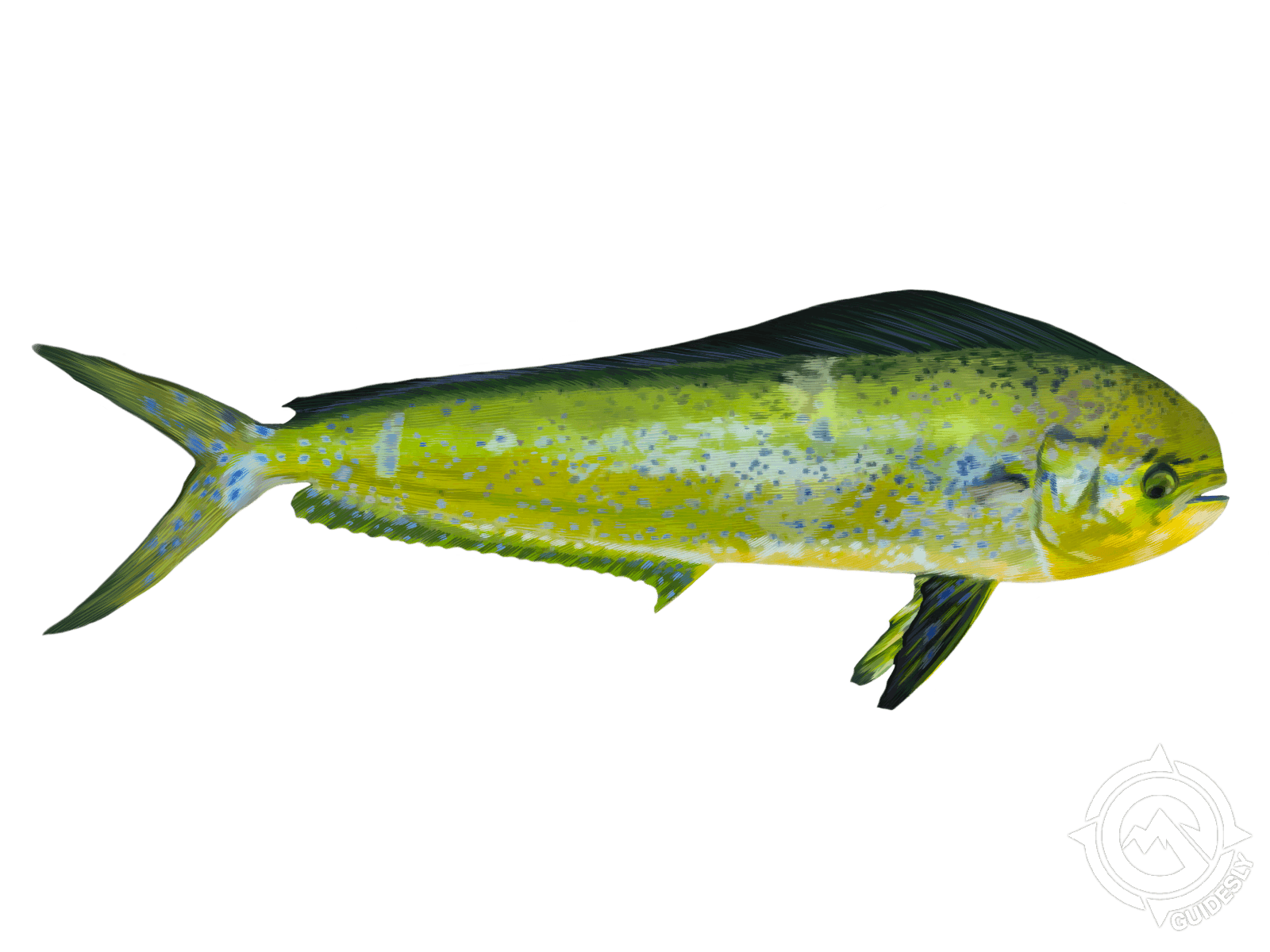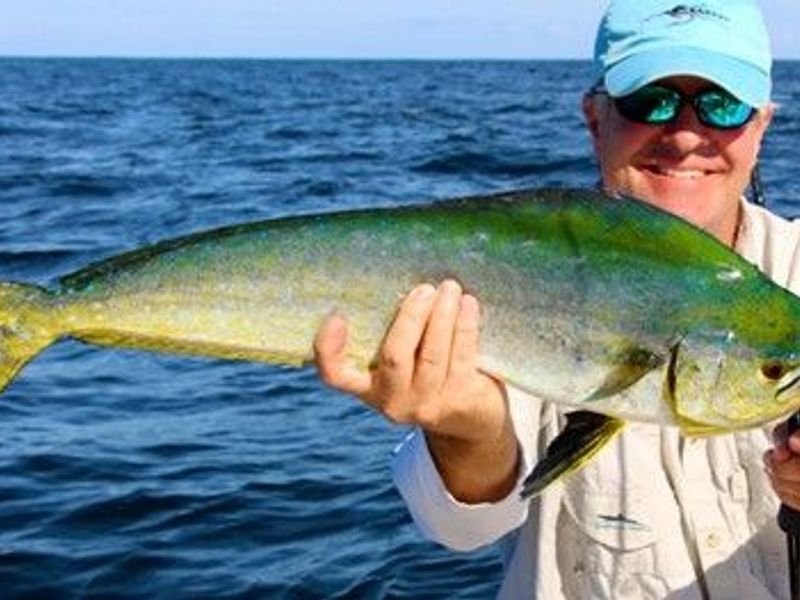Mahi Mahi or Common Dolphinfish

Species Details
Coryphaena Hippurus
Coryphaenidae
Perciformes
Offshore
15 - 30 lbs.
40" - 83"
What is the Mahi Mahi?
Learn about the Mahi Mahi or Common Dolphinfish (Coryphaena Hippurus). Find fishing info, eating tips, where they live and other interesting facts. Learn how to catch mahi mahi with our expert fishing tips. Discover the best bait, lures, and techniques to increase your chances of landing this prized fish!
Mahi Mahi or Common Dolphinfish (Coryphaena hippurus) Fish Description
The Mahi Mahi or common dolphinfish, also known as the dorado, are distinctive because of the play of colors on their bodies. Their sides are golden, with splotches of bright blue and green on the back and sides, and pectoral fins a shimmering blue, and underwater they can boast a myriad of other colors depending on where the light hits. However, once taken out of the water, they change colors drastically like a light show, before finally fading to a silver or muted yellow-grey upon demise.

The head of this fish species is also quite distinct. It is characterized by a single dorsal fin that extends from the head to the tail or caudal fin. Male Mahi Mahi have a protruding head, while the female head looks a little more rounded.
The Mahi Mahi or common dolphinfish belong to the family Coryphaenidae, with the other one being the pompano dolphinfish. The juvenile common dolphinfish are often mistaken for the pompano as the latter are quite small. One way to distinguish them is to look at the pectoral fins. The pectoral fins of the common dolphinfish are longer compared to that of the pompano. They also differ in color once out of the water. The common dolphinfish will look a little more yellow, while the pompano will sport a more prominent silver.
Why are Mahi Mahi called Dolphin Fish?
The confusion over the name Mahi Mahi started in Hawaii. The answer to why lies in the history of the Hawaiian Islands where this fish species was first discovered. In Hawaii, mahi mahi means very strong or strong-strong and fisherman referred to the fish as Mahi Mahi. That phrase caught on and the fish went from Mahi to Mahi Mahi and sometimes spelt Mahi-Mahi. It is also referred to as "dorado," However, when mahi-mahi made its way to the US mainland, it was commonly referred to as "dolphin fish." This led to confusion among consumers who thought they were buying or eating meat from actual dolphins.
There are a couple of local stories as to how that happened. It is believed that early American fishermen visiting Hawaii heard locals referring to the fish as "mahi-mahi," mistook it for a reference to dolphins and started calling it "dolphin fish." A second theory suggests that mahi-mahi's long dorsal fin may be responsible for its common name. But the Mahi Mahi, Dophinfish, Dorado is not related to Dolphins in any way.
Why are Mahi Mahi called Dorado?
Mahi Mahi are also known as Dorado, which means golden in Spanish. This name is derived from their distinctive golden-yellow coloration, which is most prominent when the fish is removed from the water. When they are in the water, their coloration is more blue and green. The name Dorado is commonly used in Latin America, occasionally in Hawaii and is also used in other parts of the world where Spanish is spoken.
Is Mahi Mahi Good to Eat?
This fish is found in tropical and subtropical waters around the world and has become popular due to its mild taste and firm texture. But the question remains - is mahi mahi a good fish to eat? Yes, Mahi-Mahi is a popular food to eat, especially in coastal regions where it is readily available. It is a firm, white-fleshed fish that has a mild, sweet flavor, which makes it appealing to a wide range of tastes. It is also a versatile fish that can be prepared in a variety of ways, including grilled, baked, fried, or broiled. In many parts of the world, Mahi-Mahi is used as a substitute for other popular fish species such as tuna or swordfish. It is a healthy fish that is rich in protein, omega-3 fatty acids, and other important nutrients. Overall, Mahi-Mahi is a popular and delicious fish that is enjoyed by many people around the world.
When it comes to taste, many people enjoy mahi mahi because it has a mild flavor that isn't too overpowering. Its flesh is typically white with pinkish hues and has a slightly sweet taste compared to other types of fish. When prepared properly, it can be a flavorful and satisfying meal. Some people describe its flavor as being similar to that of swordfish or tuna, but with a slightly milder flavor profile. The versatility of Mahi-Mahi also makes it a popular choice for a range of cuisines, from Caribbean to Asian. Overall, if you enjoy seafood, there is a good chance you will find Mahi-Mahi to be a tasty and enjoyable fish to eat.
Mahi Mahi Size and Diet
The Mahi Mahi or common dolphinfish do not live long, with some reaching five years but rarely exceeding four. They, however, spawn all year long and mature quite quickly, making their population quite strong and stable. The average size for the Mahi-Mahi is 39 inches, weighing from 15 to 29 pounds. The Mahi-Mahi world record is 87 pounds.
The Mahi Mahi are carnivorous and are known as great swimmers, making them fantastic predators. They are not very particular with what they eat, though they do adapt as they mature. The juveniles of this fish species feed on crustaceans, while the adults focus on bony fishes. They are quite partial to the flying fish. They feed mostly during the day.
Interesting Facts About the Mahi Mahi or Common Dolphinfish
- This fish species mature quickly at three to four months. They practice broadcast spawning, a reproductive behavior wherein both females and males release their respective eggs and sperms into the same water column. This practice apparently guarantees a better chance of fertilization.
- Female Mahi Mahi spawn two to three times annually. In their lifetime, they can produce millions of eggs.
- Big consumers of this fish species: the United States and the Caribbean. The Japanese, Hawaiian, and Australian markets are also significant.
- If you're catching a Mahi-Mahi to eat, make sure to store it with lots of ice before you clean it. This serves two purposes: it keeps your fish fresh, and it makes cleaning much easier.
- The flesh of the Mahi-Mahi is similar to that of the swordfish. It tastes best pan-fried, grilled, roasted, or simmered in sauce. Because its flesh is firm, it is also good to cook it over wood or coal.
- The Mahi-Mahi is also has a small instance of ciguatera poisoning, which is caused when the toxins from Gambierdiscus toxicus are consumed by the fish accidentally and grow in their bodies through time.
Fishing Technique: How to Catch Mahi Mahi or Common Dolphinfish
The common dolphinfish are prized both as game fish and as commercial species. Anglers love fishing for them because they are quite stunning to look at and can also make great food.
When fishing for the common dolphinfish, one should look for an area that has a lot of floating debris by the edge of the reef, as this fish species are attracted to such. Also, anglers should keep a look out for frigate birds trolling any floating debris as they can take you to some big catch.
This fish species can be caught with trolling near weedlines, floating debris, and currents. If you choose to do so, make sure you employ the use of 30- to 50-pound class rods and reels. With trolling, you can use live bait (ballyhoo or squid are most recommended) or artificial lures. Make the bait skip on the surface of the water to excite the common dolphinfish (they love a good flying fish for their meal, after all).
The common dolphinfish are quite strong swimmers and are quite hard to reel in, so anglers will do well with an equally strong tackle, and perhaps another one for back-up just in case the one you're using breaks off while you're reeling this strong fish in.
Is a Mahi Mahi a Tuna?
No, Mahi-Mahi, also known as dolphin fish, is not a type of tuna. Mahi-Mahi is a species of fish in the Coryphaenidae family, while tuna belongs to the Scombridae family. Although both Mahi-Mahi and tuna are popular fish to eat, they have different characteristics and are not closely related. Mahi-Mahi has a mild and sweet flavor with a firm texture, while tuna has a more robust and meaty flavor with a soft and flaky texture. Additionally, Mahi-Mahi is typically found in warmer waters, while tuna can be found in a wider range of habitats.
Why is Mahi Mahi called Dolphin?
There has been some confusion regarding whether or not mahi mahi is a dolphin. Mahi-Mahi is sometimes referred to as a dolphin or more likely, a dolphin fish, because of its similar appearance to the mammal dolphin. While both species share similar physical characteristics such as their long dorsal fins and bright colors, they are distinctly different animals. Mahi mahi belongs to the Coryphaenidae family of fish, while dolphins belong to the Delphinidae family of mammals. However, it's important to note that Mahi-Mahi is not related to dolphins in any way.
It's important to clarify this misconception because many people avoid eating mahi mahi due to their belief that it's related to dolphins. In reality, consuming responsibly sourced and properly prepared mahi mahi can be a healthy and sustainable choice for seafood lovers.
Is Mahi Mahi Safe to Eat?
When it comes to questions about its safety as a food source, many people are left wondering whether it's safe to eat or not. In general, mahi-mahi is considered safe to consume, but there are some risks associated with eating this fish that must be taken into account.
One of the main concerns regarding mahi-mahi consumption is the risk of ciguatera. Ciguatera is a type of food poisoning caused by eating fish that have consumed toxic algae. Mahi-mahi can be a carrier of this toxin if they have eaten smaller reef fish that were contaminated with ciguatoxins. Symptoms of ciguatera include vomiting, diarrhea, and neurological symptoms such as tingling sensations in the fingers and toes. While ciguatera is most commonly associated with reef fish such as barracuda and snapper, it can also affect pelagic species like mahi mahi.
Where do Mahi Mahi Live? Habitat and Distribution
This surface-dwelling fish species are typically found under floating objects. Sometimes those floating objects are floating sargassum, and sometimes they can even be ships.

The common dolphinfish are found worldwide in warm and temperate waters, distributed along the Atlantic, Pacific, and Indian Oceans. They occur in both the western parts (particularly the Sea of Japan, around the Philippine Islands, and Taiwan) and eastern parts (from the Oregon and Californian coasts to Peru) of the Pacific Ocean. In the warmer waters of Southern California, their population is quite abundant, particularly in Newport Beach San Diego, Long Beach, and Dana Point. In the Atlantic coast, they are found in Florida, particularly Miami, West Palm Beach, and the Keys.






